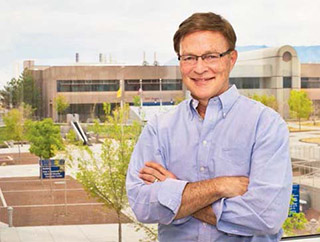New program lets researchers help companies that license their inventions

LAB TO MARKET — Pete Atherton, senior manager of Industry Partnerships Dept. 1930, says a new program that allows researchers to consult on their own time for companies that license their Sandia inventions should increase technology transfer. (Photo by Randy Montoya)
In a boost to technology transfer, Sandia has launched a program that lets researchers consult for companies that license their Sandia work.
“There is a need for this. We hear often in the business community that it would help a lot if our people could consult on their inventions,” says Pete Atherton, senior manager for Industry Partnerships Dept. 1930. “Licensees, especially small businesses, really need the technical guidance to take the next steps.”
A researcher who wants to consult for a company that licenses his or her technology must first get a green light from the Labs. Work would be done on the researcher’s own time.
A flexible approach
“This is another way to give scientists and engineers with an entrepreneurial spirit an avenue to explore business without leaving the Labs and help their work make it to the commercial market,” Pete says. “And it gives companies expertise to help commercialize a technology.”
He says the availability to consult should lead to more licensing as businesses learn they can get follow-up technical help from Sandia. “Businesses may not know how much consulting they will need until they get started,” Pete says. “This is a flexible approach that opens the door.”
The program is one of a number of ways Sandia supports technology transfer and the business community.
- The New Mexico Small Business Assistance (NMSBA) program lets for-profit companies team with Sandia researchers free of charge to solve technical challenges. In 2014, Sandia provided $2.31 million in assistance to 197 New Mexico small businesses in 27 counties. The funds come from money that Sandia otherwise would owe to the state of New Mexico in gross receipts taxes.
- Scientists can leave Sandia to launch technology companies or expand existing ones through the Entrepreneurial Separation to Transfer Technology (ESTT) program, which guarantees reinstatement if the researcher chooses to return to Sandia within three years.
- The Sandia Science and Technology Park is a 340-acre technology community adjacent to Sandia and Kirtland Air Force Base where startups and mature companies can collaborate with the Labs on a variety of technologies, products, and services. The park’s Center for Collaboration and Commercialization, or C3, now in the planning stages, will offer programs and services to strengthen partnerships, technology transfer, and ties to the community.
Enhancing tech transfer
And companies can contract to work with Sandia through Collaborative Research and Development Agreements (CRADA) and Strategic Partnership Projects, Non-Federal Entity (SPP/NFE) agreements. “These are good if the work supports a Sandia mission but more difficult for a small or startup company that is trying to understand and possibly commercialize a technology on a lean budget and time frame,” Pete says.
Andy McIlroy, Sandia’s deputy chief technology officer and director of the Research Strategy and Partnerships Center 1900, says the consulting option will enhance tech transfer. “Through an innovative portfolio of mutually reinforcing initiatives, Sandia continues to be a leader in effectively transferring technology to the private sector for the widest possible benefit to the taxpayer,” he says.